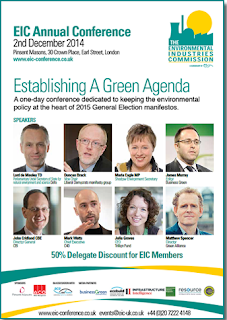The first Yosemite Sustainability Conference will take place on December 8 - 11, at the Curry Village Pavilion, Curry Village, Yosemite, in Yosemite National Park. The conference is a three-day learning and networking forum dedicated to helping businesses, government agencies, and non-profit organizations transition to economic, environmental, and social sustainability.
The conference will provide information about best practices related to environmental issues such as climate change, greenhouse gas reduction, water management, energy management, waste stream reduction and transportation fuels. Attendees will learn about implementable solutions, tools, resources, from experts in the fields of water, energy, waste management and air resources.
The conference will provide information and demonstrations of existing Yosemite sustainable systems and processes. Attendees will also have the opportunity to interact with industry professionals and hear from experts on some of the world's most intriguing environmental concerns and sustainability practices, as well as emerging technologies to deal with these concerns.
This hands on conference is focused on providing implementable solutions when you leave. It will connect people looking for solutions to those who have the answers.
This conference supports Yosemite’s 2020 Strategic Vision, which urges that “…we carry out our mission and core values, and is a call to action for every person that comes in contact with Yosemite National Park to model sustainability.” This message will reach more than 4,000,000 Park visitors each year.
Among the keynote speakers is Tim Carey, senior director for sustainability and recycling at PepsiCo. Other keynote speakers include:
Don Neubacher, Yosemite National Park superintendent
Debbie Freidel,director of sustainability for Delaware North
Dan Jensen, president of Delaware North at Yosemite
Ann Krcik, director, brand communication & outdoor exploration, The North Face
Who Should Attend
The Yosemite Sustainability Conference is designed for individuals who manage sustainability as part of their job or have an interest in sustainable practices. Anyone from government agencies, public land management agencies, private business, tribes, and those wishing to learn better sustainable and environmentally friendly practices will benefit from attending this conference.
The conference is a joint presentation of Yosemite Gateway Partners (YGP) and Yosemite National Park (NPS).
About YGP
Yosemite Gateway Partners is a non-profit organization made up of individuals from surrounding communities that have a vested interest in Yosemite National Park. YGP has been working with the National Park Service (NPS) since 2006 and has been involved with the park on many important issues. This year, YGP would like to give back to the park and local communities by hosting the first ever Yosemite Sustainability Conference in Yosemite Valley.
YGP is a partnership of government agencies, non-profit organizations, individuals and businesses that acknowledge the interdependence of Yosemite National Park and the surrounding communities, and collaborate on and address issues of regional importance to create sustainable cultural, natural and economic prosperity.This is an open membership organization, and there are no fees or dues.
The event cost is $395 (includes meals). Discounted lodging rates are available.
To register click here, for registration or for more information, visit yosemitegatewaypartners.org/, or call (209) 962-7990.
The conference will provide information about best practices related to environmental issues such as climate change, greenhouse gas reduction, water management, energy management, waste stream reduction and transportation fuels. Attendees will learn about implementable solutions, tools, resources, from experts in the fields of water, energy, waste management and air resources.
The conference will provide information and demonstrations of existing Yosemite sustainable systems and processes. Attendees will also have the opportunity to interact with industry professionals and hear from experts on some of the world's most intriguing environmental concerns and sustainability practices, as well as emerging technologies to deal with these concerns.
This hands on conference is focused on providing implementable solutions when you leave. It will connect people looking for solutions to those who have the answers.
This conference supports Yosemite’s 2020 Strategic Vision, which urges that “…we carry out our mission and core values, and is a call to action for every person that comes in contact with Yosemite National Park to model sustainability.” This message will reach more than 4,000,000 Park visitors each year.
Among the keynote speakers is Tim Carey, senior director for sustainability and recycling at PepsiCo. Other keynote speakers include:
Don Neubacher, Yosemite National Park superintendent
Debbie Freidel,director of sustainability for Delaware North
Dan Jensen, president of Delaware North at Yosemite
Ann Krcik, director, brand communication & outdoor exploration, The North Face
Who Should Attend
The Yosemite Sustainability Conference is designed for individuals who manage sustainability as part of their job or have an interest in sustainable practices. Anyone from government agencies, public land management agencies, private business, tribes, and those wishing to learn better sustainable and environmentally friendly practices will benefit from attending this conference.
The conference is a joint presentation of Yosemite Gateway Partners (YGP) and Yosemite National Park (NPS).
About YGP
Yosemite Gateway Partners is a non-profit organization made up of individuals from surrounding communities that have a vested interest in Yosemite National Park. YGP has been working with the National Park Service (NPS) since 2006 and has been involved with the park on many important issues. This year, YGP would like to give back to the park and local communities by hosting the first ever Yosemite Sustainability Conference in Yosemite Valley.
YGP is a partnership of government agencies, non-profit organizations, individuals and businesses that acknowledge the interdependence of Yosemite National Park and the surrounding communities, and collaborate on and address issues of regional importance to create sustainable cultural, natural and economic prosperity.This is an open membership organization, and there are no fees or dues.
The event cost is $395 (includes meals). Discounted lodging rates are available.
To register click here, for registration or for more information, visit yosemitegatewaypartners.org/, or call (209) 962-7990.



















































